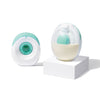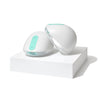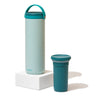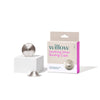Regardless, they're both BLAH.

Chances are, you never heard of a milk blister, or bleb, before you started breastfeeding. A bleb is basically a blister that can crop up when your milk gets backed up behind a blocked milk duct opening. You might notice it in the form of a tiny white spot at or near the very tip of your nipple.
What is a milk blister or bleb?
A bleb, commonly called a milk blister, can arise when your milk thickens and gets backed up. It appears as a raised section of skin with milk beneath it either on or near your nipple. When this happens, a small white or yellow spot resembling a whitehead can appear.
When do blebs occur?
Blebs most often form in the early weeks and months of nursing, and tend to be linked to improper latching. However, they can happen at any point during your breastfeeding journey, even as you attempt to wean from breastfeeding, and can take a week to clear up.
What causes milk blisters?
Blebs are typically a symptom of an underlying issue that prevents milk from flowing freely. Common causes include:
-
Poor Latch: The most common cause. An improper latch means your breasts aren't being drained effectively.
-
Ill-Fitting Pump Flanges: Flanges that are too tight or too small can compress the nipple and ducts, leading to blockages.
-
Oversupply: Producing more milk than your baby drinks can lead to milk stagnation and thickening.
-
Pressure on Breasts: Tight bras or restrictive clothing can put pressure on ducts.
-
Weaning: As feedings become less frequent, milk can thicken and become more prone to blockages.
Note! If you have recurrent milk blisters, get in touch with your provider.
Related Reading: Common Breast Conditions Tied to Breastfeeding
How to Treat a Milk Bleb at Home: A Step-by-Step Guide
Important Note: Always start with the least invasive methods first to avoid infection and tissue damage.
-
Apply Warmth & Moisture: Before feeding, place a warm, wet compress on the bleb for 5-10 minutes. You can also take a warm shower and let the water run over your breast.
-
Gentle Massage: While the area is warm, use your fingers to gently massage the bleb and the breast tissue behind it in a circular motion toward the nipple.
-
Feed or Pump Immediately: Offer the affected breast first, when your baby's suck is strongest. If the pain is too great, use a pump.
-
Try Different Positions: Experiment with nursing positions (like the "football hold") to help drain the affected duct more effectively.
-
Use Saline Soaks: Dissolve 1/2 teaspoon of salt in a cup of warm water. Soak a cotton ball and apply it to the bleb for 10-15 minutes before feeding. This can help draw out the blockage and soften the skin.
-
Air Dry: After feeding, let your breasts air dry completely. Avoid tight, damp bras.
What to do when you have a milk bleb
Try to continue breastfeeding normally, especially on the nipple where the bleb is located. If the bleb is painful, try the following interventions:
-
See a lactation consultant to ensure that your baby is latching properly.
-
Place a warm, clean cloth over the bleb, and massage it before expressing milk.
-
Hand-express some milk prior to feeding to try to clear the blockage.
-
Breastfeed or pump more often to maintain supply while preventing engorgement or mastitis.
-
Air out your breasts—bacteria thrive in tight, damp areas—by going topless or braless when you can, and wash your tops and bras regularly.
-
If the bleb is protruding from the skin, you can try to gently lift it with clean fingers yourself (much like you might with a callous), but know that there are risks, such as introducing more bacteria. Ideally, just leave it alone, because playing with it can make it worse or recurrent.
What NOT to Do
-
Do NOT pop it with a needle. This is a last-resort medical procedure. Doing it yourself at home significantly increases the risk of a serious infection.
-
Do NOT aggressively pick or scratch at it. This can cause more inflammation and scarring, making the problem worse.
When to Seek Professional Help
While many blebs resolve with home care, contact a healthcare provider or an International Board Certified Lactation Consultant (IBCLC) if:
-
The bleb is extremely painful and doesn't improve after 2-3 days of consistent home treatment.
-
You develop a fever, chills, or body aches (signs of infection or mastitis) . (Blebs can also lead to clogged ducts.).
-
The surrounding breast tissue becomes red, swollen, hot, and painful.
-
You experience recurrent blebs, which indicate an ongoing issue like a persistent poor latch that needs to be addressed.
A professional can safely lance the bleb with a sterile needle or may prescribe a topical antibiotic ointment to prevent infection.
Find Comfort and Confidence with Willow
Dealing with nursing challenges like milk blebs is stressful enough without worrying about your pump adding to the problem. A poor-fitting flange is a common culprit.
The Willow Go Wearable Pump is designed with comfort in mind and offers resources to help you find your correct flange size, ensuring effective milk removal without unnecessary friction or pressure.
Learn More Tips for New Parents with Willow
At Willow, we understand how hard it can be to transition into life after having a baby. That's why we created the Willow blog, which provides expert advice on lifestyle adjustments, postpartum self-care, parenting and more!
Tags Used
















